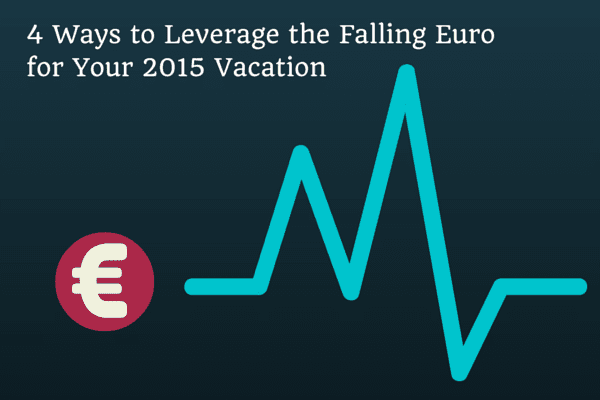 Budget-savvy travelers are headed for Europe this summer and here’s why: For the last decade, U.S. travelers visiting Europe have been at an economic disadvantage, due to the value of the euro relative to the U.S. dollar. At the euro’s strongest in late 2008, it took $1.60 to buy €1 of goods or services in Europe. But in the last year, the euro has fallen considerably – most precipitously in the last quarter – and at the time of this writing, is now valued at around $1.19. Simply put, that means a European vacation is much less expensive now.
Budget-savvy travelers are headed for Europe this summer and here’s why: For the last decade, U.S. travelers visiting Europe have been at an economic disadvantage, due to the value of the euro relative to the U.S. dollar. At the euro’s strongest in late 2008, it took $1.60 to buy €1 of goods or services in Europe. But in the last year, the euro has fallen considerably – most precipitously in the last quarter – and at the time of this writing, is now valued at around $1.19. Simply put, that means a European vacation is much less expensive now.
Ways to Leverage the Falling Euro
If you’ve always wanted to take a cooking class in Tuscany, study the art of the Grand Masters in the Louvre, or see and be seen on the Mediterranean Riviera, now’s the time to do it! Whether it’s your first trip abroad or you’ve already visited many of Europe’s major highlights, incredible history, beauty, culture and cuisine are there waiting for you to discover. Europe is a great value right now, especially if you use these trip planning tactics.
 Book your airline ticket now. If you’re departing from the U.S., your ticket will be priced in U.S. dollars so currency fluctuation doesn’t come into play, but availability does. Summer is high season for Europe and favorable exchange rates will entice even more U.S. travelers to “jump the pond.” Every itinerary offers multiple price points on the any given plane and the lowest – in economy or business class – are snapped up first. With more people looking for tickets, you’ll do better to get there first. Also, higher demand could tempt the airlines to increase fares, so purchase your ticket to protect your price.
Book your airline ticket now. If you’re departing from the U.S., your ticket will be priced in U.S. dollars so currency fluctuation doesn’t come into play, but availability does. Summer is high season for Europe and favorable exchange rates will entice even more U.S. travelers to “jump the pond.” Every itinerary offers multiple price points on the any given plane and the lowest – in economy or business class – are snapped up first. With more people looking for tickets, you’ll do better to get there first. Also, higher demand could tempt the airlines to increase fares, so purchase your ticket to protect your price.- Prepay for hotels and tours in advance. Currency is notoriously volatile and the euro could indeed bounce back.* Prepaying any services in advance effectively locks in the current exchange rate. A hotel that costs €200 per night is currently $238. Should the euro bounce back to, say, 1.30 that same €200 becomes $260. That $22 a night difference over a two week vacation could pay for an elegant dinner, some extra shopping or a bonus excursion.
-

Photo courtesy of Viking River Cruises Upgrade your travel experience. Take advantage of the falling euro to get more out of the same budget. You could make the long flight more comfortable in business class, upgrade to a luxurious room with a view, or extend your trip. Travel Maestro tip: Our Virtuoso membership allows us to include exclusive complimentary amenities, such as room upgrades, in-room gifts, and early check-in/late check-out at many of Europe’s finest hotels.
- Buy euros now.* There are several ways you can purchase euros at the current exchange rate to use for your travel-related expenses later. Prepaid, reloadable cards are popular and available from many sources. They’re widely accepted and offer the security of replacement if lost or stolen, but purchase fees and ATM withdrawal fees can be hefty. Compare among card vendors before purchasing. You can also buy cash euros at your local bank – usually with a flat fee, regardless of amount. Cash avoids any usage fees, but of course there’s no recourse if lost or stolen. Foreign currency bank accounts are a third option. They often don’t charge monthly fees, but usually require a sizable minimum balance, so they are typically used more by investors than for single-trip travel.
Without a doubt, 2015 is the most economical year in a decade to visit Europe. So go visit a castle, sip wine in a vineyard, or train from capital to capital. For assistance in planning your trip, contact the Europe Specialists at Covington Travel.
* Travel Maestro Disclosure: Of course, the euro could also continue its decline, in which case services will be even less expensive (in dollars) than they are now and you could be disappointed that you didn’t wait to exchange currency. In fact, Goldman Sachs predicts that the euro could drop to $1.08 by the end of 2015, and be equal to the dollar by the end of 2016. I’m a travel advisor, not a currency forecaster, so please see your financial advisor for market advice.






Leave a Reply